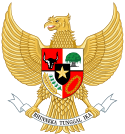Indonesian presidential line of succession
Script error: No such module "AfC submission catcheck".
 |
|---|
| This article is part of a series on the politics and government of Indonesia |
The Indonesian presidential line of succession is the order in which officials of the Government of Indonesia assume the powers and duties of the office of President of Indonesia in the event that the president is unable to discharge the functions of the office, such as due to death, resignation, removal, or incapacity.
Constitutional provisions[edit]
The Constitution of Indonesia does not explicitly specify a line of succession after the Vice President of Indonesia. However, it provides some general guidelines for filling a vacancy in the presidency. Article 8 states that if the president dies, resigns, or is unable to perform their duties for any reason, they shall be replaced by the vice president for the remaining term of office.
Article 22A states that if both the president and vice president die, resign, or are unable to perform their duties for any reason, the government shall be taken over by a person appointed by law. The person appointed by law shall hold office until a new president and vice president are elected within 30 days.
Article 22B states that if both the president and vice president die, resign, or are unable to perform their duties for any reason within two years after their election, a new presidential election shall be held within 60 days. The person appointed by law shall hold office until a new president and vice president are elected.[1]
Statutory provisions[edit]
The law that appoints a person to take over the government in case both the president and vice president are unavailable is Law No. 7 of 1974 on Presidential Succession. This law was enacted during the New Order regime of Suharto, and has not been amended or repealed since then.
According to this law, the person appointed by law to take over the government is the Chairperson of the People's Consultative Assembly (MPR), which is the highest legislative body in Indonesia. The Chairperson of MPR shall exercise all the powers and duties of the president until a new president and vice president are elected.
If the Chairperson of MPR is unable or unwilling to take over the government, then the law provides a further line of succession as follows:
- The Chairperson of the People's Representative Council (DPR), which is the lower house of parliament.
- The Chairperson of the Regional Representative Council (DPD), which is the upper house of parliament.
- The Chief Justice of the Supreme Court of Indonesia.
- The Attorney General.
If none of these officials are able or willing to take over the government, then the law authorizes the MPR to appoint another person as acting president.[2]
Current line of succession[edit]
As of April 2023, the current line of succession to the presidency of Indonesia is as follows:
- Ma'ruf Amin, Vice President
- Bambang Soesatyo, Chairperson of MPR
- Puan Maharani, Chairperson of DPR
- La Nyalla Mattalitti, Chairperson of DPD
- Muhammad Syarifuddin, Chief Justice of Supreme Court
- Sanitiar Burhanuddin, Attorney General
Historical cases[edit]
There have been three occasions in Indonesian history when the presidential line of succession was invoked.
Sukarno's removal[edit]
In 1967, President Sukarno was removed from office by a decree of MPR, which accused him of abusing his powers and violating the constitution. The MPR appointed Suharto, who was then the commander-in-chief of the armed forces, as acting president. Suharto was formally elected as president by MPR in 1968.[3]
Suharto's resignation[edit]
In 1998, President Suharto resigned from office amid mass protests and economic crisis. He was succeeded by his vice president, B.J. Habibie, who became acting president. Habibie was formally elected as president by MPR in 1999.[4]
Abdurrahman Wahid's impeachment[edit]
In 2001, President Abdurrahman Wahid was impeached by MPR for alleged corruption and incompetence. He was replaced by his vice president, Megawati Sukarnoputri, who became acting president.[5] Megawati was formally elected as president by MPR in 2001.[6]
See also[edit]
- List of presidents of Indonesia
- Vice President of Indonesia
- People's Consultative Assembly
- Government of Indonesia
References[edit]
- ↑ "Constitution of Indonesia" (PDF). 2002. Retrieved 30 October 2022.
- ↑ "Law No. 7 of 1974 on Presidential Succession". 1974. Retrieved 30 October 2022.
- ↑ "Suharto". Britannica. Retrieved 30 October 2022.
- ↑ "B.J. Habibie". Britannica. Retrieved 30 October 2022.
- ↑ "Indonesia country profile - Leaders". BBC. 15 February 2012. Retrieved 30 October 2022.
- ↑ "Megawati Sukarnoputri". Britannica. Retrieved 30 October 2022.
External links[edit]
This article "Indonesian presidential line of succession" is from Wikipedia. The list of its authors can be seen in its historical and/or the page Edithistory:Indonesian presidential line of succession. Articles copied from Draft Namespace on Wikipedia could be seen on the Draft Namespace of Wikipedia and not main one.
